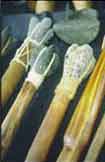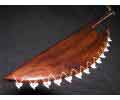
Hawaiian History
& Culture
Hawaiian
Tiki Gods
Ancient Hawaiian
Weapons
Ancient warriors of Hawaii, or Koa, used a variety of intriguing weapons. They were arcane masters of shape achieved for dark purposes, weapon making was an inventive and deadly art. Tactics of ancient Hawaiians included raining missile weapons, like deadly sling stones and spears down upon enemies from high arcs. Closing with pikes, spears 12' to 15' long in a formation allowing the first ranks or warriors to attack their enemies. Then decimating foes in melee combat with a terrifying array of ancient weapons. These weapons included short spears, clubs, shark toothed clubs, strangulation cords, trip weapons, throwing axes and the infamous hawaiian daggers. Kao warriors were brutal and disciplined. The nobles wore spectacular feather capes as a form of armor. Kao warriors practiced an ancient marshal art called Lua, in it they trained to kill by breaking bones, using pressure points, and more.

Hawaiian Arms
Stone Maces, Spears and
Trip Weapons.

Hawaiian Weapons of War
Engraving, Cook's Voyages
1785
Hawaiian Weaponry Sections:
1. Intro
2. Weaponry of Hawaii
a. Pikes and Spears
b. Melee Weaponry
c. Missile Weaponry
3. Koa Warriors and Armor
4. Lua (Hawaiian Martial Arts)
Weaponry of Hawaii - Spears and Pikes

In ancient Hawaii, unlike other ancient tribal (feudal) people from polynesia or Micronesia, the spear or pike was the main weapon of their armies. These weapons had several variations and styles. Pike weapon formations were the anvil that opposing armies were smashed on in ancient Hawaii. These 12' to 15' foot weapons allowed
several ranks of ancient hawaiian warriors to attack at once. These linear formations advanced on to enemies presenting a wall of barbed (these would break off in a punctured enemy) spear points. Using their weapons in a similar way to the phalanxes of Alexander the great. This main body of ancient warriors moved steadily forward while other koa warriors, equipped with melee weaponry that allowed more speed and maneuverability. It has been theorized that these weapons were used by Hawaiian commoners, but royal spear companies are known to have existed. These would have been a disciplined core to the ancient royal armies of hawaii. The second spear weapon is the short spear, these would have been used by ancient hawaiian melee units for close combat. These weapons ranged from 4-6 feet long and generally used as a thrusting weapon or for leg sweeping. Ancient koa warriors were masters of this weapon and spent hours each day perfecting their technique in the ancient art of lua. The final type of spear weapon was the javelin and it is covered under missile weapons below. Spears were made out of dense tropical wood, so dense that they sinks in water.
Weaponry of Hawaii - Melee Weapons



Short spears and stone clubs made up the bulk of Hawaiian close melee weapons. Short spears were not larger at the base like the longer pikes. Stone clubs were in fact stone maces, similar to European designs.
Hawaiian weapons also included wooden tripping weapons, or pikoi, which had long cords attached to variously shaped club-like heads with or without handles. The weighted part of the rope was thrown at an opponent's legs to trip him, and then another weapon, perhaps a stone hand club shaped like today's hand-held weights with bulbous ends and a slimmer connecting section to grasp, would be used to finish off the tripped enemy.
Daggers were unique to Hawaii amongst the polynesian islands. Five kinds of daggers were written about by early explorers. They were the heavy truncheon dagger with a hole in the handle for a loop made of olona fiber to be attached, long-bladed daggers, shark-tooth or marlin bladed daggers , bludgeon daggers and curved bladed daggers. Captain James Cook wrote about them himself:
"They have a sort of weapon which we had never seen before, and not mentioned by any navigator, as used by the natives of the South Sea. It was somewhat like a dagger; in general, about a foot and a half long, sharpened at one or both ends, and secured to the hand by a string. Its use is to stab in close fight; and it seems well adapted to the purpose. Some of these may be called double daggers, having a handle in the middle with which they are better enabled to strike both ways."
Another ancient weapon of Hawaii is the strangle cord, generally made of woven olona fiber. Bishop Museum displays several of these cords with ivory or wooden handles attached. Unlike the rest of Polynesia, Hawai'i had a designated public executioner, who meted out punishment to those who broke the kapu (established taboos, or laws). The executioner, called "mu," prepared victims for sacrifice and used the strangling cord to dispense of them to the god of war, Ku.
Weaponry of Hawaii - Missile Weapons

Throwing Axe
Ancient Hawaiian Slings
When it came to warfare the sling was the weapon with the longest range and was the deadliest weapon. Bows and arrows were known in ancient Hawaii, however they were used only for games and hunting. This is similar to warfare in the ancient Greek world where contemporary writers and military historians mentions that sling weapons out ranged bows (at Thermopoly for example). Early Hawaiian's crafted rounded conical stones from the dense volcanic rock making an extremely deadly weapon. Rocks can be flung two to three times the speed thrown, distances from modern slingers using these archaic arms can be from 100 - 200 yards. These were fashioned out of a pouch woven of strips of hau situated in the center of longer plaited ropes.
Hawaiian Throwing Weapons
As opposing Hawaiian armies came even closer it was time to let lose the javelins. These attractive and deadly spears are 6'- 8' and 'decorated' with sharks teeth for serration and feathers. The armies of ancient Rome used javelins, called pilla, in a similar manner before their legions closed with enemy ranks. Once enemies were within approximately 20', Hawaiian throwing axes could be used. These weapons were serrated and used to target individuals with high accuracy. They could be used to hit a warriors legs to trip them or to kill with a deadly strike to the neck or chest. These exquisite, original hawaiian, arms were usually not a primary weapon, but one were one more strike from their deadly arsenal.
Ancient Hawaiian Warriors and Armor
Tribal Warriors or Ancient Commando Army?
Ancient Hawaiian warriors, or Koa, gave their name to the hard wood tree that most of their weaponry was carved from. They shaved before battle and lathered their bodies with oil to prevent enemies from getting a grip on them. Warriors specialized in various arms but carried multiple back up weapons into combat. A warrior might use a missile weapon (Javelin, Sling), followed by a first strike weapon (Trip Weapon) and then finally use a finishing off type weapon (Dagger, club). They entered battle only wearing a loin cloth, however nobles wore protective helmets, capes and in the final years of ancient Hawaiian combat even woven armor. The helmets were made of gourds or woven fibers and protected a warriors head from missiles. Hawaiian nobles wore capes, also made of woven fibers but with feathers, that they held in their left hands and used to block attacks and or to trip enemies before finishing them off with the weapon in their right hand. The capes and crests of Hawaiian nobles were covered with red, yellow, and black feathers in colorful patterns. The King of ancient Hawaii had a "King Akhenaten's Sword" of sorts in his cape, passed from high king to high king.
Grant Dyck wrote:
"Body-tattooing was common, and was more elaborate among nobles. It typically featured concentric circles, or lines, or various animal patterns. In one instance, a queen who lamented the death of her husband had her tongue tattooed. When asked if it hurt, she said 'not in comparison to the loss of my husband.'"
Kao warriors were brutal, stayed fit with olympic style games and trained constantly at their arts. Nobles used an ancient Hawaiian martial art called Lua. They specialized in bone breaking among other deadly techniques. Captured enemies might have their end trails removed and all of their bones broken before being transported to a temple for sacrifice. On the brighter side, battles could at times be averted by singular battle of two champions though.
Lua - The Ancient Hawaiian Martial Art
Origins: Ancient Hawaii. The exact age of the art is disputed. It is generally accepted however, that Lua has existed for almost as long as Polynesians have inhabited Hawaii.
Lua History and Its Decline: Lua is much more than a martial art. It is a Hawaiian cultural legacy. One famous Lua practitioner was King Kamehameha, who united all the islands by 1810.
Lua had a strict "Kapu" or oath, that forbid practitioners from teaching people outside of their class or to non Hawaiians. Eventually, with the influx of missionaries, Lua was looked down upon as a pagan, "black" art, and was forced underground. Over the years, the Lua all but died out.
The Rebirth of Lua: The Lua style was saved by a handful of people who worked to spread the art to Hawaiians as a cultural treasure. These people included Charles Kenn, who studied Lua during the first quarter of the 20th century, his students Richard Paglinawan, Jerry Walker, Mitchell and Dennis Eli, and Moses Kalauokalani, and Solomon Kaihewalu, who teaches his own family's particular style of Lua. Through the work of these dedicated Olohe, or masters, Lua is making a comeback.
Philosophy: Lua is a system of fighting based on the theory of duality. Lua warriors would combine the traits of Ku, the god of war, and Hina, the goddess of the moon. Lua seeks to balance good and evil, male and female, destruction and healing, dark and light.
Characteristics: Lua's combat system consists of kuikui (punching),peku (kicking),hakihaki (bone- breaking), hakoko (wrestling) and aalolo (pressure point attacks). However in keeping with the focus on duality, there is also a focus on healing. Lua practitioners historically trained in lomi lomi massage, as well as other natural methods of healing.
Similarities to Other Styles: Lua utilizes dance or "kata" in their martial art system, similar in method to capoeira. This martial dance is called haka. It is is said that lua and haka are the mother to hula, the famous Hawaiian dance. The dances were used to calm warriors before battle, intimidate their enemies, and to hide martial techniques from those seeking to steal them.

A Leather Sling